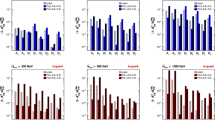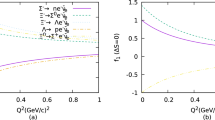Summary
It is argued that if exotic mesons exist at all, backward scattering is the most favourable reaction to search for them. In particular, for exotics with masses around (1.5÷2) GeV, their backward production in π- or K-nucleon collisions is expected to be comparable to the one observed for vector or tensor mesons.
Riassunto
Si arguisce, che se i mesoni esotici esistono, lo scattering all’indietro è la reazione più favorevole per la loro ricerca. In particolare, per gli esotici con masse (1.5÷2) GeV, si prevede che la loro produzione all’indietro, nelle collisioni di π e K su nucleoni, è confrontabile con quella osservata per i mesoni vettoriali o tensoriali.
Резюме
Доказывается, что если, вообще, экзотические мезоны существуют, то обратное рассеяние представляет наиболее благоприятную реакцию для поиска этих мезонов. В частности, для экзотических мезонов с массами около (1.5÷2) ГэВ ожидается, что их рождение при обратном рассеянии в π-или К-нуклонных соударениях сравнимо с наблюденным рождением векторных или тензорных мезонов.
Similar content being viewed by others
References
Particle Data Group:Rev. Mod. Phys.,42, 142 (1970).
M. Gell-Mann:Phys. Lett.,8, 214 (1964);G. Zweig: CERN preprints TH. 401 and 412 (1964).
C. B. Chiu andJ. Finkelstein:Phys. Lett.,27 B, 510 (1968);C. Schmid:Lett. Nuovo Cimento,1, 165 (1969);R. Capps:Phys. Rev. Lett.,22, 215 (1969);J. Mandula, C. Rebbi, R. Slansky, J. Weyers andG. Zweig:Phys. Rev. Lett.,22, 1147 (1969);V. Barger andC. Michael:Phys. Rev.,186, 1592 (1969).
J. Rosner:Phys. Rev. Lett.,21, 950, 1468(E) (1968).
J. Mandula, J. Weyers andG. Zweig:Phys. Rev. Lett.,23, 266 (1969);Patterns of exchange degeneracy, CALT-68-248, to be submitted toAnn. Rev. Nucl. Sci.
S. Andersson, C. Daum, F. Erné, J. P. Lagnaux, J. C. Sens, F. Udo andF. Wagner: Contribution to the Lund Conference (1969);J. G. Asbury, J. D. Dowell, S. Kato, D. Lundquist, T. B. Novey, A. Yokosawa, B. Barnett, P. Koehler andP. Steinberg:Phys. Rev. Lett.,23, 194 (1969).
P. G. O. Freund, J. Rosner andR. Waltz:Nucl. Phys.,13 B, 237 (1969).
We ignore the possibility that the second A2 could be exotic.
The limits which can be put on exotic exchanges comparing for instance processes such as\(p\bar p \to \Sigma ^ + \bar \Sigma ^ + \) and\(p\bar p \to \Sigma ^ - \Sigma ^ - \) are still rather high. The ratio of the nonexotic to the exotic part of the amplitude could be as low as 5. Indeed it is through the study of reactions where both exotic and nonexotic exchanges area priori present that the exotic contribution could be best seen through its interference effects. Nevertheless, the allowed processes for exotic production call for exotic exchange. Forward exotic production is then an inefficient way to look for exotic exchange. This would include double Regge exchange (cut contribution) as well as exotic Regge exchange.
J. Rosner:Phys. Rev. Lett.,22, 689 (1969);H. Harari:Phys. Rev. Lett.,22, 562 (1969).
Even more exotic mesons can of course be produced in meson-nucleon reactions but they require associate production of exotic baryons. They would only appear at still higher energies.
Exotic resonances being expected to show up only at low spin and high mass, they affect only highly inelastic partial waves. As a result no neat exotic peak is expected to appear against the nonresonant background. It is only starting with theS orU regions, where resonance saturation could fully break down, that we could expect to start seeing significant features most likely involving some significant baryonantibaryon decay.
J. Rosner:Eastern Theoretical Physics Conference, Syracuse, N. Y. (1969).
This seems to us an interesting experiment for a device such as the CERN Omega.
C. Rebbi andR. Slansky:Rev. Mod. Phys.,42, 68 (1970).
Author information
Authors and Affiliations
Additional information
To speed up publication, the author of this paper has agreed to not receive the proofs for correction.
Traduzione a cura della Redazione.
Переведено редакцией.
An erratum to this article is available at http://dx.doi.org/10.1007/BF02758985.
Rights and permissions
About this article
Cite this article
Jacob, M., Weyers, J. In search of exotic states. Nuovo Cimento A (1965-1970) 69, 521–528 (1970). https://doi.org/10.1007/BF02726488
Received:
Published:
Issue Date:
DOI: https://doi.org/10.1007/BF02726488




